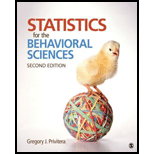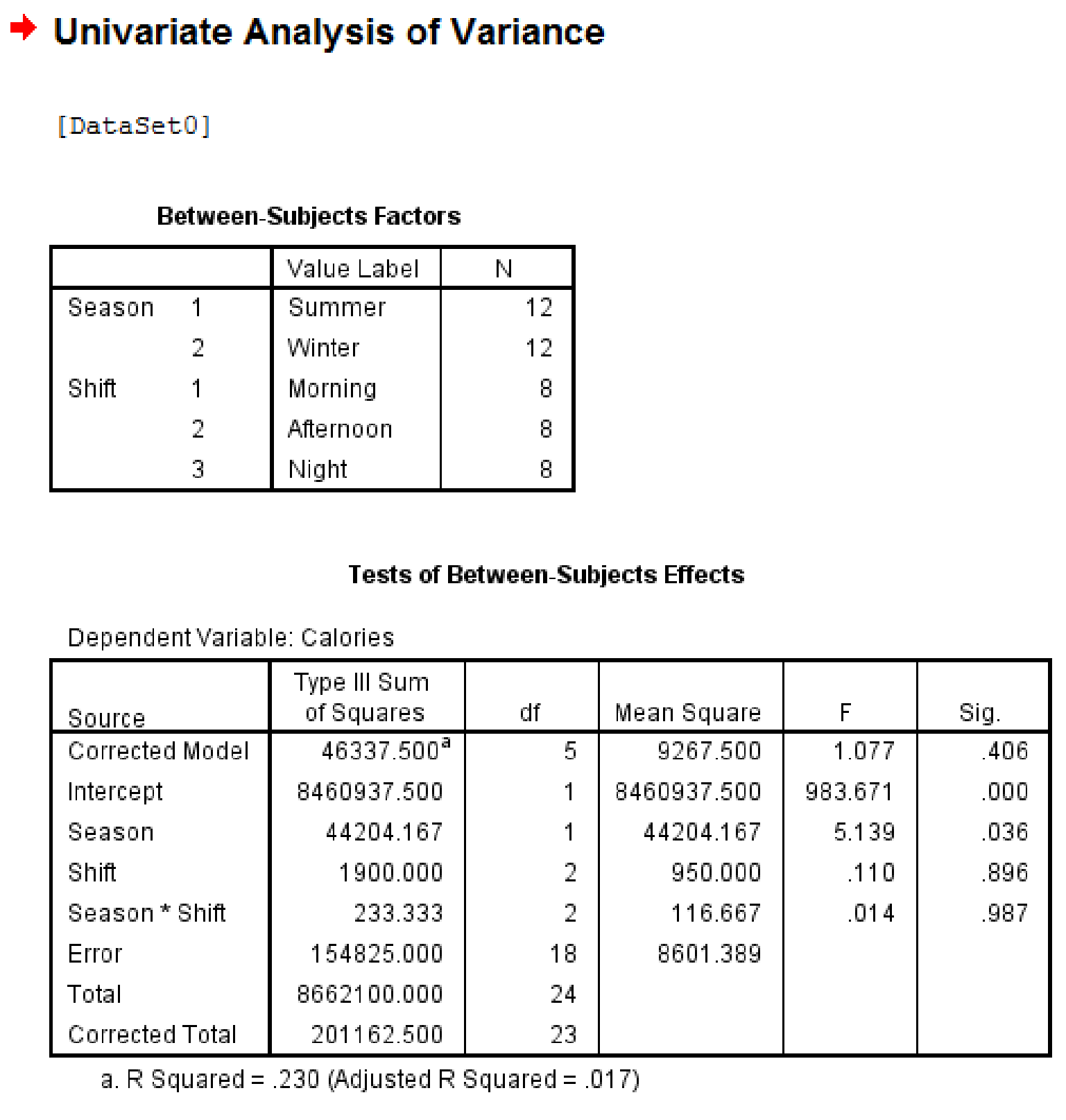
Concept explainers
(a)
Complete the F table.
Determine whether decision to retain or rejectthe null hypothesis for each hypothesis test.
(a)
Answer to Problem 22CAP
The completedF table is,
| Source of Variation | SS | df | MS | |
| Season | 44,204.17 | 1 | 44,204.17 | 5.139 |
| Shift | 1,900.00 | 2 | 950.00 | 0.110 |
| Season | 233.34 | 2 | 116.67 | 0.014 |
| Error | 154,825.00 | 18 | 8,601.39 | |
| Total | 201,162.51 | 23 |
The decision is to reject the null hypothesis for Season, the group means for main effect Season (summer, winter) do significantly vary in the population.
The decision is to retain the null hypothesis for shift, the group means for main effect shift (morning, afternoon, evening) do not significantly vary in the population.
The decision is to retainthe null hypothesis for interaction effect; the means of season do not significantly vary by shift or the combinations of these factors.
Explanation of Solution
Calculation:
From the information given that, the study is based on the eating patterns that might contribute toobesity and these measures the average number of calories (permeal) consumed by shift workers (morning, afternoon, night)during two seasons (summer and winter).
Software procedure:
Step by step procedure to obtain the Two-way between-subjects ANOVA using SPSS software is given as,
- Choose Variable view.
- Under the name, enter the names as Season, Shift andCalories.
- Choose Data view, enter the data for as Season, Shift andCalories, respectively.
- Choose Analyze>General Linear Model>Univariate.
- Enter calories in Dependent variable dialog box.
- Send as Season, Shift into Fixed factors.
- Click on Options button.
- Send Season, Shift into Display Means for dialog box.
- Click on Continue button.
- Click OK.
Output using SPSS software is given below:

The completed F table is,
| Source of Variation | SS | df | MS | |
| Season | 44,204.17 | 1 | 44,204.17 | 5.139 |
| Shift | 1,900.00 | 2 | 950.00 | 0.110 |
| Season | 233.34 | 2 | 116.67 | 0.014 |
| Error | 154,825.00 | 18 | 8,601.39 | |
| Total | 201,162.51 | 23 |
Decision rules:
- If the test statistic value is greater than the critical value, then reject the null hypothesis
- If the test statistic value is smaller than the critical value, then retain the null hypothesis
Hypothesis test for main effect factor A (Season):
Let
Null hypothesis:
That is, the group means for main effect Season (summer, winter) do not significantly vary in the population.
Alternative hypothesis:
That is, the group means for main effect Season (summer, winter) do significantly vary in the population.
Critical value:
The considered significance level is
The degrees of freedom for numerator are 1, the degrees of freedom for denominator are 18 from completed F table.
From the Appendix B: Table B.3-Critical values for F distribution:
- Locate the value 1 in degrees of freedom numerator row.
- Locate the value 18 in degrees of freedom denominator row.
- Locate the 0.05 level of significance (value in lightface type) in combined row.
- The intersecting value that corresponds to the (1, 18) with level of significance 0.05 is 4.41.
Thus, the critical value for
Conclusion:
The value of test statistic is 5.139.
The critical value is 4.41.
The test statistic value is greater than the critical value.
The test statistic value falls under critical region.
Hence the null hypothesis is rejected.
The decision is the group means for main effect Season (summer, winter) do significantly vary in the population.
Hypothesis test for main effect factor B (Shift):
Let
Null hypothesis:
That is, the group means for main effect shift (morning, afternoon, evening) do not significantly vary in the population.
Alternative hypothesis:
That is, the group means for main effect shift (morning, afternoon, evening) do significantly vary in the population.
Critical value:
The considered significance level is
The degrees of freedom for numerator are 2, the degrees of freedom for denominator are 18 from completed F table.
From the Appendix B: Table B.3-Critical values for F distribution:
- Locate the value 2 in degrees of freedom numerator row.
- Locate the value 18 in degrees of freedom denominator row.
- Locate the 0.05 level of significance (value in lightface type) in combined row.
- The intersecting value that corresponds to the (2, 18) with level of significance 0.05 is 3.55.
Thus, the critical value for
Conclusion:
The value of test statistic is 0.110.
The critical value is 3.55.
The test statistic value is less than the critical value.
The test statistic value does not falls under critical region.
Hence the null hypothesis is retained.
The decision is the group means for main effect shift (morning, afternoon, evening) do significantly vary in the population.
Hypothesis test for interaction effect of factor A and B:
Let
Null hypothesis:
That is, the means of season do not significantly vary by shift or the combinations of these factors.
Alternative hypothesis:
That is, the means of season do significantly vary by shift or the combinations of these factors.
Critical value:
The considered significance level is
Thus, the critical value for
Conclusion:
The value of test statistic is 0.014.
The critical value is 3.55.
The test statistic value is less than the critical value.
The test statistic value does not falls under critical region.
Hence the null hypothesis is retained.
The decision is the means of season do not significantly vary by shift or the combinations of these factors.
2.
Explain why the tests of post hoc are not necessary.
2.
Answer to Problem 22CAP
The tests of post hoc are not necessary for this test because only the main effect ‘season’ is significant and another main effect ‘shift’ is not significant.
Explanation of Solution
Justification: The post hoc tests are conducted only when the two main effects in the study are significant. The result of the study is that the main effect ‘season’ is significant this effect has only two levels, but another main effect ‘shift’ is not significant and also the interaction effect bewteen both the factors is not significant. This shows that, conducting post hoc tests is not necessary since the main effect ‘shift’ is not significant.
Want to see more full solutions like this?
Chapter 14 Solutions
Statistics for the Behavioral Sciences
- Please help me answer the following questions from this problem.arrow_forwardPlease help me find the sample variance for this question.arrow_forwardCrumbs Cookies was interested in seeing if there was an association between cookie flavor and whether or not there was frosting. Given are the results of the last week's orders. Frosting No Frosting Total Sugar Cookie 50 Red Velvet 66 136 Chocolate Chip 58 Total 220 400 Which category has the greatest joint frequency? Chocolate chip cookies with frosting Sugar cookies with no frosting Chocolate chip cookies Cookies with frostingarrow_forward
- The table given shows the length, in feet, of dolphins at an aquarium. 7 15 10 18 18 15 9 22 Are there any outliers in the data? There is an outlier at 22 feet. There is an outlier at 7 feet. There are outliers at 7 and 22 feet. There are no outliers.arrow_forwardStart by summarizing the key events in a clear and persuasive manner on the article Endrikat, J., Guenther, T. W., & Titus, R. (2020). Consequences of Strategic Performance Measurement Systems: A Meta-Analytic Review. Journal of Management Accounting Research?arrow_forwardThe table below was compiled for a middle school from the 2003 English/Language Arts PACT exam. Grade 6 7 8 Below Basic 60 62 76 Basic 87 134 140 Proficient 87 102 100 Advanced 42 24 21 Partition the likelihood ratio test statistic into 6 independent 1 df components. What conclusions can you draw from these components?arrow_forward
- What is the value of the maximum likelihood estimate, θ, of θ based on these data? Justify your answer. What does the value of θ suggest about the value of θ for this biased die compared with the value of θ associated with a fair, unbiased, die?arrow_forwardShow that L′(θ) = Cθ394(1 −2θ)604(395 −2000θ).arrow_forwarda) Let X and Y be independent random variables both with the same mean µ=0. Define a new random variable W = aX +bY, where a and b are constants. (i) Obtain an expression for E(W).arrow_forward
- The table below shows the estimated effects for a logistic regression model with squamous cell esophageal cancer (Y = 1, yes; Y = 0, no) as the response. Smoking status (S) equals 1 for at least one pack per day and 0 otherwise, alcohol consumption (A) equals the average number of alcohoic drinks consumed per day, and race (R) equals 1 for blacks and 0 for whites. Variable Effect (β) P-value Intercept -7.00 <0.01 Alcohol use 0.10 0.03 Smoking 1.20 <0.01 Race 0.30 0.02 Race × smoking 0.20 0.04 Write-out the prediction equation (i.e., the logistic regression model) when R = 0 and again when R = 1. Find the fitted Y S conditional odds ratio in each case. Next, write-out the logistic regression model when S = 0 and again when S = 1. Find the fitted Y R conditional odds ratio in each case.arrow_forwardThe chi-squared goodness-of-fit test can be used to test if data comes from a specific continuous distribution by binning the data to make it categorical. Using the OpenIntro Statistics county_complete dataset, test the hypothesis that the persons_per_household 2019 values come from a normal distribution with mean and standard deviation equal to that variable's mean and standard deviation. Use signficance level a = 0.01. In your solution you should 1. Formulate the hypotheses 2. Fill in this table Range (-⁰⁰, 2.34] (2.34, 2.81] (2.81, 3.27] (3.27,00) Observed 802 Expected 854.2 The first row has been filled in. That should give you a hint for how to calculate the expected frequencies. Remember that the expected frequencies are calculated under the assumption that the null hypothesis is true. FYI, the bounderies for each range were obtained using JASP's drag-and-drop cut function with 8 levels. Then some of the groups were merged. 3. Check any conditions required by the chi-squared…arrow_forwardSuppose that you want to estimate the mean monthly gross income of all households in your local community. You decide to estimate this population parameter by calling 150 randomly selected residents and asking each individual to report the household’s monthly income. Assume that you use the local phone directory as the frame in selecting the households to be included in your sample. What are some possible sources of error that might arise in your effort to estimate the population mean?arrow_forward
 MATLAB: An Introduction with ApplicationsStatisticsISBN:9781119256830Author:Amos GilatPublisher:John Wiley & Sons Inc
MATLAB: An Introduction with ApplicationsStatisticsISBN:9781119256830Author:Amos GilatPublisher:John Wiley & Sons Inc Probability and Statistics for Engineering and th...StatisticsISBN:9781305251809Author:Jay L. DevorePublisher:Cengage Learning
Probability and Statistics for Engineering and th...StatisticsISBN:9781305251809Author:Jay L. DevorePublisher:Cengage Learning Statistics for The Behavioral Sciences (MindTap C...StatisticsISBN:9781305504912Author:Frederick J Gravetter, Larry B. WallnauPublisher:Cengage Learning
Statistics for The Behavioral Sciences (MindTap C...StatisticsISBN:9781305504912Author:Frederick J Gravetter, Larry B. WallnauPublisher:Cengage Learning Elementary Statistics: Picturing the World (7th E...StatisticsISBN:9780134683416Author:Ron Larson, Betsy FarberPublisher:PEARSON
Elementary Statistics: Picturing the World (7th E...StatisticsISBN:9780134683416Author:Ron Larson, Betsy FarberPublisher:PEARSON The Basic Practice of StatisticsStatisticsISBN:9781319042578Author:David S. Moore, William I. Notz, Michael A. FlignerPublisher:W. H. Freeman
The Basic Practice of StatisticsStatisticsISBN:9781319042578Author:David S. Moore, William I. Notz, Michael A. FlignerPublisher:W. H. Freeman Introduction to the Practice of StatisticsStatisticsISBN:9781319013387Author:David S. Moore, George P. McCabe, Bruce A. CraigPublisher:W. H. Freeman
Introduction to the Practice of StatisticsStatisticsISBN:9781319013387Author:David S. Moore, George P. McCabe, Bruce A. CraigPublisher:W. H. Freeman





